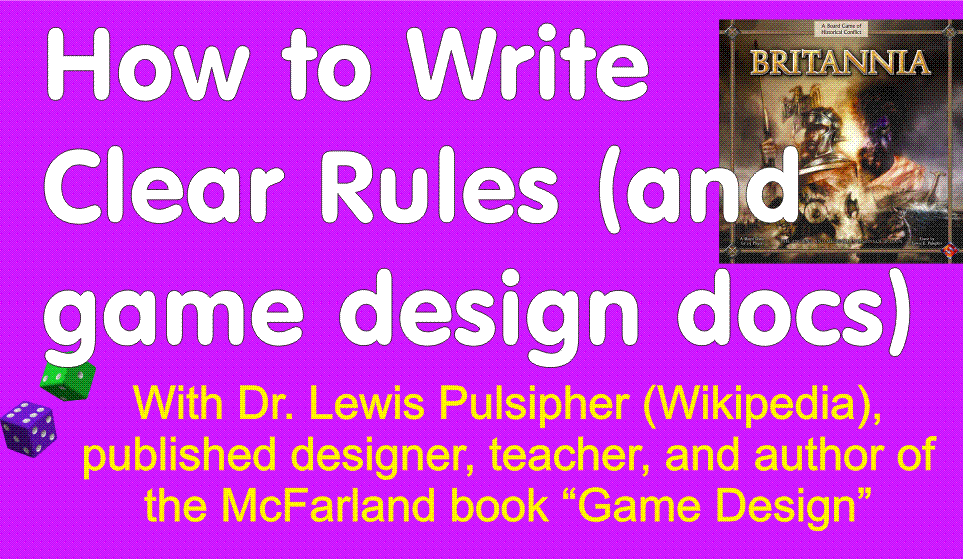I assigned groups of three or four students (generally self-selected groups) the task of creating one non-electronic game and one electronic game. Among other things, I wanted them to see how much easier it is to produce a non-electronic prototype and be able to play it. I wanted them to see how important it is to play a game again and again, modify it again and again, to get a better product.
(There's a serious problem in the game design literature that implies that game design is writing up ideas, and once a prototype is produced--not a preliminary stand-alone prototype, but the prototype that becomes the finished game--the designer's work is just about over. In other words, there's a tendency to think that when the prototype works, you're nearly done. Even books that state clearly how much time is required to work with the playable prototype to achieve a good game, don't illustrate it in practice or in the amount of space devoted to these vital ideas.)
I tried to enforce milestones during many weeks of this process, but in the end I gave students the opportunity to fail. At one point I took each group out in the hallway, sat on the floor (their choice whether they did or not), and had them show me the prototype they had so far. For the "final" version, not final as in done, but final as in we've-run-out-of-time even though it isn't complete, I decided to have them "present" to the entire class, so people could see what others were doing.
Two of my classes are too large for everyone to "gather round a table" and watch, so in those classes the students had to stand up front. And it rapidly became clear that it is very hard to adequately describe a game without playing it, or at least setting it up. One group did produce a set of Powerpoint slides to help illustrate how the game worked, and another took digital photos of a playtest session.
A smaller class gathering around a table works better; then the "presenters" actually play a little of the game, which generates lots of questions. I can also see easily whether they've actually played it before, as those who have not run into lots of mechanics questions they had not thought of.
In general, the more practical games were the simple ones. Not only is this hardly surprising, it helps illustrate the point I'm trying to make, "keep it simple". My motto is "A designer knows he has achieved perfection not when there is nothing left to add, but when there is nothing left to take away." (Antoine de Saint-Exup'ery)
The simple games were also easier to playtest multiple times, of course.
There were many analogs of electronic games, such as boardgame shooters. There were also analogs of card games, such as collectible/tradable card game and a couple of my own games that students had played in the game club. There was even a game that strongly resembled Candyland! Despite my discussion of the faults of traditional games (still be to posted here), some of the games started with the dreaded "roll and move" mechanic of Monopoly, though I did talk some students out of it. Certainly, where most students are not boardgame players and are just starting to design games, the games they produce are likely to be analogs of/derivative of other games.
Some of the games were not playtested, some were playtested a lot. I think those who did do playtesting recognized how important it was. In a few cases a group threw away their first effort after playtesting. I don't encourage this, but in some cases it was certainly justified.
It's very difficult for anyone to "grade" these games without playing them several times, for which there is no time. My main criterion, aside from what I can see about the gameplay, is whether the students playtested the games and benefitted from that.
I also give them a peer evaluation sheet to fill out. The idea is that I may find out which people in the group actually contributed most, or least. It has its flaws, but is better than nothing.
Later in "lecture" class we made a list of lessons learned from the non-digital game project:
• Playtesting really makes a difference
• You can’t know whether the game is much good until you play several times.
• Working in groups is tough
• It always takes more time than you think
• Miscommunication is common
• The last point is more technical, but important:
Symmetry in starting positions removes most worries about balance/fairness (you still must worry if a first-mover or even last-mover in a round has an advantage).
Thursday, December 6, 2007
Subscribe to:
Post Comments (Atom)
"Always do right--this will gratify some and astonish the rest."Mark Twain
"A designer knows he has achieved perfection not when there is nothing left to add, but when there is nothing left to take away." Antoine de Saint-Exup'ery
"Not everything that can be counted counts, and not everything that counts can be counted." Albert Einstein
"Make everything as simple as possible, but not simpler." Albert Einstein





1 comment:
So, how DO you grade these things, if you're simultaneously looking at the quality (assumed to be proportional to playtesting time) while still giving the "opportunity to fail" (which I assume means that they can still pass the class even if their game turned out terrible, as long as they learned something)?
I have the same issue in my design classes so I'd be interested to know how you balance those things.
Post a Comment